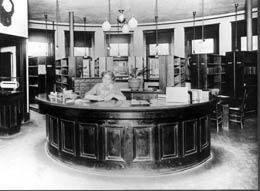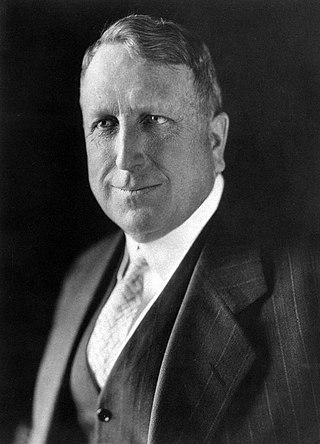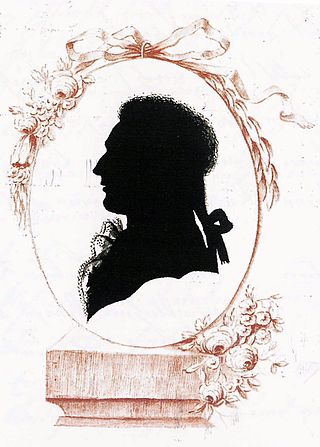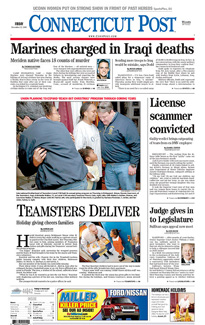
A comic strip is a sequence of cartoons, arranged in interrelated panels to display brief humor or form a narrative, often serialized, with text in balloons and captions. Traditionally, throughout the 20th and into the 21st century, these have been published in newspapers and magazines, with daily horizontal strips printed in black-and-white in newspapers, while Sunday papers offered longer sequences in special color comics sections. With the advent of the internet, online comic strips began to appear as webcomics.

The reference desk or information desk of a library is a public service counter where professional librarians provide library users with direction to library materials, advice on library collections and services, and expertise on multiple kinds of information from multiple sources.

The Yellow Kid is an American comic strip character that appeared from 1895 to 1898 in Joseph Pulitzer's New York World, and later William Randolph Hearst's New York Journal. Created and drawn by Richard F. Outcault in the comic strip Hogan's Alley, it was one of the first Sunday supplement comic strips in an American newspaper, although its graphical layout had already been thoroughly established in political and other, purely-for-entertainment cartoons. Outcault's use of word balloons in the Yellow Kid influenced the basic appearance and use of balloons in subsequent newspaper comic strips and comic books.

William Randolph Hearst Sr. was an American businessman, newspaper publisher, and politician known for developing the nation's largest newspaper chain and media company, Hearst Communications. His flamboyant methods of yellow journalism influenced the nation's popular media by emphasizing sensationalism and human interest stories. Hearst entered the publishing business in 1887 with Mitchell Trubitt after being given control of The San Francisco Examiner by his wealthy father, Senator George Hearst.
Yellow journalism and yellow press are American terms for journalism and associated newspapers that present little or no legitimate, well-researched news while instead using eye-catching headlines for increased sales. Techniques may include exaggerations of news events, scandal-mongering, or sensationalism. By extension, the term yellow journalism is used today as a pejorative to decry any journalism that treats news in an unprofessional or unethical fashion.

The Internet Archive is an American digital library with the stated mission of "universal access to all knowledge." It provides free public access to collections of digitized materials, including websites, software applications/games, music, movies/videos, moving images, and millions of books. In addition to its archiving function, the Archive is an activist organization, advocating a free and open Internet. As of January 1, 2023, the Internet Archive holds over 36 million books and texts, 11.6 million movies, videos and TV shows and clips, 950 thousand software programs, 15 million audio files, 4.5 million images, 251 thousand concerts, and 780 billion web pages in the Wayback Machine.
Electronic publishing includes the digital publication of e-books, digital magazines, and the development of digital libraries and catalogues. It also includes the editing of books, journals, and magazines to be posted on a screen.

Stationery refers to commercially manufactured writing materials, including cut paper, envelopes, writing implements, continuous form paper, and other office supplies. Stationery includes materials to be written on by hand or by equipment such as computer printers.

Yoshitaka Amano is a Japanese visual artist, character designer, illustrator, a scenic designer for theatre and film, and a costume designer. He first came into prominence in the late 1960s working on the anime adaptation of Speed Racer. Amano later became the creator of iconic and influential characters such as Gatchaman, Tekkaman, Honeybee Hutch, and Casshern. In 1982 he went independent and became a freelance artist, finding success as an illustrator for numerous authors, and worked on best-selling novel series, such as The Guin Saga and Vampire Hunter D. He is also known for his commissioned illustrations for the popular video game franchise Final Fantasy.

Letterpress printing is a technique of relief printing for producing many copies by repeated direct impression of an inked, raised surface against individual sheets of paper or a continuous roll of paper. A worker composes and locks movable type into the "bed" or "chase" of a press, inks it, and presses paper against it to transfer the ink from the type, which creates an impression on the paper.

A silhouette is the image of a person, animal, object or scene represented as a solid shape of a single colour, usually black, with its edges matching the outline of the subject. The interior of a silhouette is featureless, and the silhouette is usually presented on a light background, usually white, or none at all. The silhouette differs from an outline, which depicts the edge of an object in a linear form, while a silhouette appears as a solid shape. Silhouette images may be created in any visual artistic medium, but were first used to describe pieces of cut paper, which were then stuck to a backing in a contrasting colour, and often framed.

The New York Journal-American was a daily newspaper published in New York City from 1937 to 1966. The Journal-American was the product of a merger between two New York newspapers owned by William Randolph Hearst: The New York American, a morning paper, and the New York Evening Journal, an afternoon paper. Both were published by Hearst from 1895 to 1937. The American and Evening Journal merged in 1937.

The Milwaukee Journal Sentinel is a daily morning broadsheet printed in Milwaukee, Wisconsin, where it is the primary newspaper. It is also the largest newspaper in the state of Wisconsin, where it is widely distributed. It is currently owned by the Gannett Company.

The Houston Post was a newspaper that had its headquarters in Houston, Texas, United States. In 1995, the newspaper shut down, and its assets were purchased by the Houston Chronicle.

Douglas S. Wildey was an American cartoonist and comic book artist best known for creating the 1964 animated television series Jonny Quest for Hanna-Barbera Productions.
The Daily Reveille has been since 1887 the student newspaper at Louisiana State University in Baton Rouge, Louisiana. It prints once a week on Wednesdays during the fall, spring and summer semesters. The Daily Reveille has a weekly circulation of about 6,000 copies.

The Connecticut Post is a daily newspaper located in Bridgeport, Connecticut. It serves Fairfield County and the Lower Naugatuck Valley. Municipalities in the Post's circulation area include Ansonia, Bridgeport, Darien, Derby, Easton, Fairfield, Milford, Monroe, New Canaan, Orange, Oxford, Redding, Ridgefield, Seymour, Shelton, Stratford, Trumbull, Weston, Westport and Wilton. The newspaper is owned and operated by the Hearst Corporation, a multinational corporate media conglomerate with $4 billion in revenues. The Connecticut Post also gains revenue by offering classified advertising for job hunters with minimal regulations and separate listings for products and services.

The California State Library is the state library of the State of California, founded in 1850 by the California State Legislature. The Library collects, preserves, generates and disseminates a wide array of information. Today, it is the central reference and research library for state government and the Legislature. The California State Library advises, consults with and provides technical assistance to California's public libraries. It directs state and federal funds to support local public libraries and statewide library programs, including Institute of Museum and Library Services (IMLS) grants. The California State Library's mission is to serve as "...the state’s information hub, preserving California’s cultural heritage and connecting people, libraries and government to the resources and tools they need to succeed and to build a strong California." With the exception of the Sutro Library in the J. Paul Leonard Library at San Francisco State University, the other three branches are located in Sacramento, California, at 914 Capitol Mall, 900 N Street and at the State Capitol.
The Combat Paper is a project formed to help veterans cope with experiences in the war. It was based out of the Green Door Studio in Burlington, Vermont in the United States. Their processes include making paper out of their old uniforms to then create art on them as well as many other creative outlets for them to connect to fellow veterans. They have exhibits and workshops available to further expand their knowledge as well as connect on a more national level with others.
The San Francisco Examiner is a newspaper distributed in and around San Francisco, California, and published since 1863.














